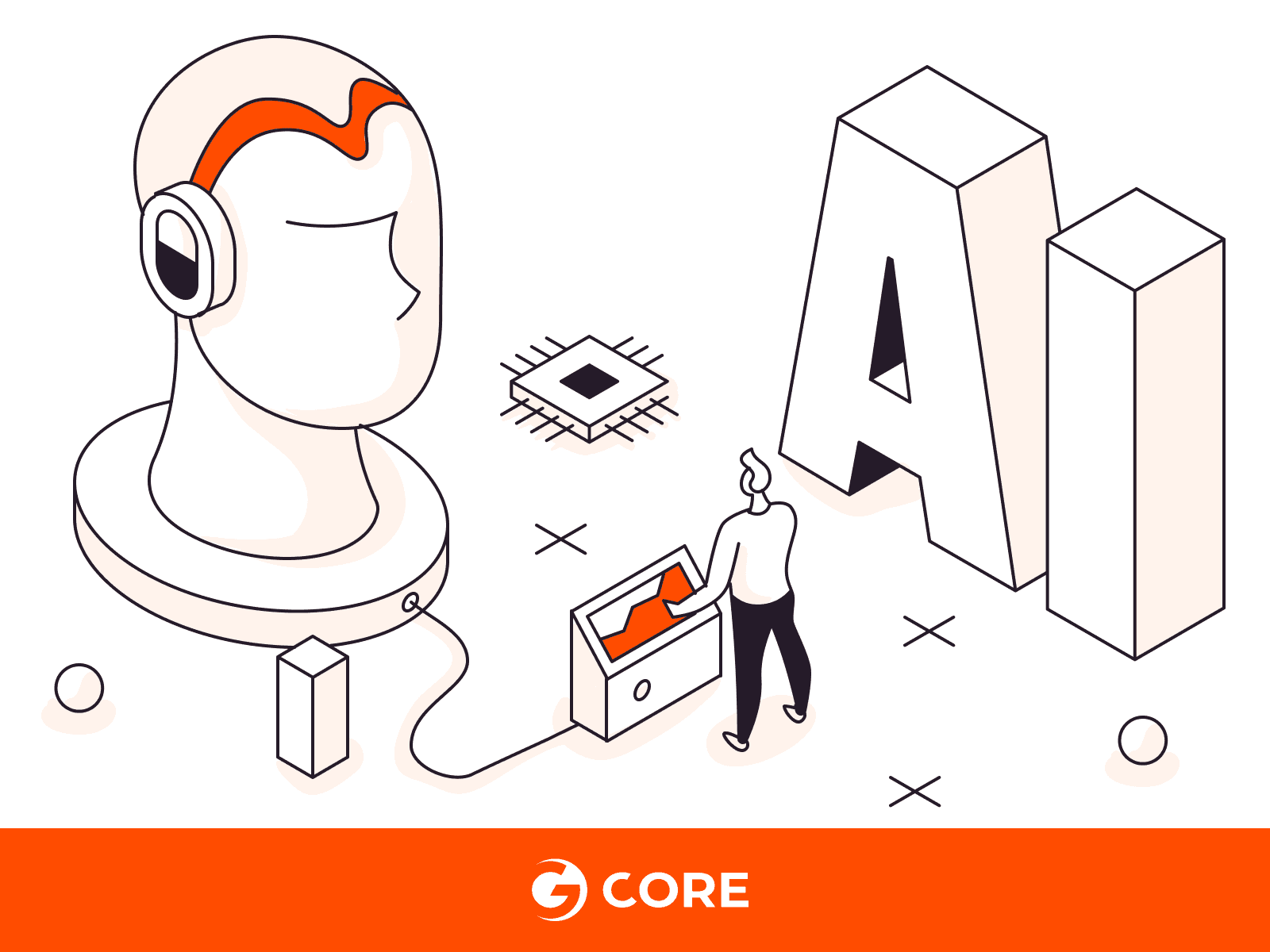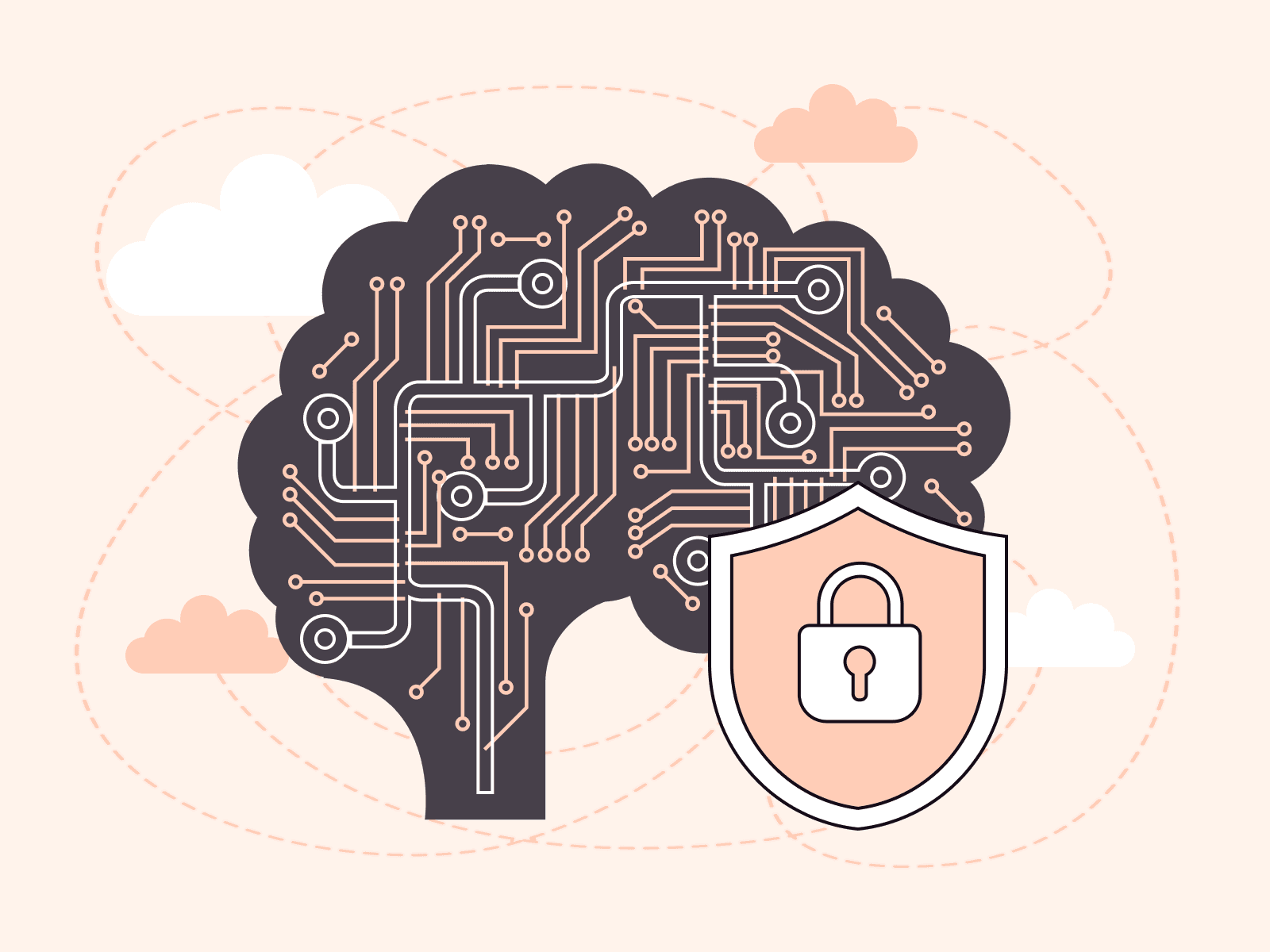Artificial intelligence (AI) can process vast amounts of data, learning from previous experiences to predict outcomes, optimize processes, and even generate new ideas. As AI becomes increasingly integrated into our digital infrastructure, its technical intricacies should be understood—so in this detailed article, we’ll delve into what AI is, how it’s used, pros and cons of its use, how it works, and future trends.
What Is AI?
Artificial intelligence (AI) is the simulation of human intelligence in machines to perform complex decision-making and problem-solving tasks. These machines replicate human behavior by applying logic, learning from mistakes, and adapting to new information.
As an interdisciplinary field, AI synergizes knowledge from mathematics, computer science, psychology, neuroscience, cognitive science, linguistics, operations research, and economics. It employs a diverse toolkit of methods and technologies—such as search algorithms, logic programming, decision trees, and neural networks—to develop transformative and diverse applications. These include natural language processing (NLP,) robotics, and customer service.
Within the expansive realm of AI lie specialized subsets, such as machine learning (ML). ML is a subset of AI that uses algorithms to analyze data, learn from it, and make decisions. Another subset is deep learning (DL), which delves into complex neural networks —interconnected layers of algorithms—to analyze data in more nuanced ways. As AI keeps advancing, these subsets play key roles in transforming industries, solving complicated issues, and opening new possibilities.
Key Concepts
Understanding AI starts with knowing three fundamental terms used in this field.
- Artificial intelligence: The field of AI simulates human intelligence in machines. It involves algorithms for searching data, decision-making trees, expert systems that mimic human expertise, and robotics.
- Machine learning: A branch of AI focusing on statistical models learning from data. It focuses on making predictions or decisions without explicit programming.
- Deep learning: A subset of ML employing complex neural networks. This is more advanced and can process a higher quantity of data.
Types of Artificial Intelligence
The table below outlines the various types of artificial intelligence and their core functions, spanning from simple task-specific systems to the profound concept of machine consciousness. It also highlights what sets each type apart from the others. Understanding these differences will enable you to make smart decisions about what type(s) of AI is/are relevant to your organization.
| Reactive machines | Limited memory | Theory of mind | Self-awareness | |
| Definition | Simplest AI form | AI that can remember past information | Advanced stage AI with social intelligence | Theoretical, most advanced AI |
| Function | Performing specific tasks without memory of past experiences | Applying past experiences to future tasks | Understanding human emotions and predicting behavior | Comprehending their own existence and state |
| Example | Deep Blue, a chess-playing AI | Self-driving cars using previous experiences to make informed decisions | Potential for more harmonious human interaction | Potential for enhanced decision-making and human interaction |
| Other comments | Cannot utilize past experiences for future decisions | Improved decision-making processes | More theoretical, not fully realized | Raises ethical considerations and technological challenges |
AI Applications
AI has become indispensable in various industries, providing innovative solutions to complex problems. Traditional methods and practices have been transformed by AI-oriented advanced technologies that are tailored to specific needs.
Healthcare
In the healthcare industry, AI is overhauling diagnostics and enabling personalized treatment. AI allows the creation of individualized treatment plans by analyzing a patient’s medical history, genetic makeup, and lifestyle. For example, machine learning models might determine the optimal drug dosage for a particular patient. AI can also recognize early signs of diseases like cancer through the interpretation of medical images, such as X-rays and MRIs, using deep learning techniques.
E-commerce
E-commerce leverages artificial intelligence to enhance customer experience through personalized product suggestions and fraud detection. By analyzing customers’ purchase history and browsing behavior, artificial intelligence algorithms can offer product recommendations that align with individual preferences. Additionally, AI-powered systems can analyze transaction patterns to detect and prevent fraudulent activities, while chatbots can be used to promote a better customer experience.
Cybersecurity
The field of cybersecurity employs AI for threat detection and prevention. Continuous monitoring of network activities with AI-driven tools enables the recognition of unusual patterns indicative of a breach. Real-time analyses trigger immediate responses to contain threats, while predictive models forecast potential vulnerabilities, reinforcing defenses using techniques like neural network analysis.
Transportation
In transportation, AI is at the forefront of autonomous driving and traffic management. Self-driving vehicles use AI algorithms to process sensor data for real-time decisions about steering, braking, and route planning. Convolutional neural networks allow the vehicle to respond dynamically to its surroundings. AI also aids in traffic flow optimization through intelligent analysis of camera and sensor data, providing route suggestions and minimizing congestion.
AI in Everyday Life
The influence of AI extends to our daily lives through virtual assistants and home automation. Virtual assistants like Siri and Alexa, powered by natural language processing (NLP) algorithms, understand and respond to voice commands. Home automation systems enable intelligent control of household appliances, such as smart thermostats that adjust heating or lighting.
AI Advantages and Disadvantages
Artificial intelligence’s integration across industries leads to both advantages and disadvantages that shape the way we work and live.
| Advantages | Disadvantages |
| Efficiency gains and cost reductions: AI can save time and reduce costs by automating routine tasks, leading to higher efficiency. For example, AI in banking could create up to $340 billion in savings annually through risk management and revenue generation. | Ethical concerns: Issues such as bias, misinformation, and copyright infringement arise with AI. Careful consideration and regulation are required, but not yet routinely or consistently used. |
| New markets and business models: AI allows for the creation of new markets and business models. In entertainment, AI recognizes plagiarism and develops high-definition graphics, transforming media consumption. | Integration issues: Since AI is still in its early phases, it might not integrate well with existing workflows. This integration gap can hinder progress and adaptation. |
| Enhanced human creativity: AI frees humans to focus on creative activities by taking care of mundane tasks. | Adoption challenges: Not everyone is prepared to embrace AI, making it hard for some to adopt. Customers may also be hesitant, doubting its utility and value. |
| Improved customer experience: AI helps when launching new features and speeds up customer service response times, thus increasing customer satisfaction. | |
| Innovative and technological advancements: The application of AI in fields like medicine offers improvements in diagnosing patients and the creation of data-driven healthcare policies. | Data demands: AI requires substantial, high-quality data from which to learn. |
| Safer practices: AI is improving the safety of many industries, such as financial fraud detection, IoT-enabled machine monitoring, and personalized medicine. | Job replacement and development costs: The costs associated with developing AI and the potential to replace human jobs create economic and social concerns. However, AI also stands to create new jobs, some yet to be invented. |
How AI Works
To understand how artificial intelligence works, let’s break the process down into distinct steps using the example of developing a predictive maintenance system in the industrial sector.

Step 1: Understanding the Problem
Since AI exists to solve problems, the first step is to identify which problem you’re trying to solve. This often starts with a rigorous needs assessment that defines the scope and limitations of what the artificial intelligence model is expected to achieve. This might include defining specific hypotheses, understanding the nature of the data you will work with, and identifying what success looks like in measurable terms, such as reducing manual task time or improving the accuracy of a diagnostic tool. Stakeholder interviews and domain-specific literature reviews are often conducted at this stage to understand the problem fully.
For predictive maintenance, the aim is to detect early signs of machine failure, thereby reducing downtime and false-positive rates. Clear objectives, constraints, assumptions, and potential risks must be outlined at this stage.
Step 2: Preparing the Data
This stage involves a focus on meticulous data preparation. Imbalanced data sets are corrected, gaps in the data are addressed, and anomalies—known as outliers—are removed to enhance the model’s reliability, and the right model type is chosen.
For predictive maintenance, data such as sensor readings, logs, and historical records, are collected. Sensor malfunctions and other irregularities must be rectified, and imbalanced data should be managed through techniques like resampling.
Step 3: Converting the Data
Converting raw data into a usable format involves cleaning it, which means removing any errors or missing values. Then, you transform it into a standard format. Normalizing comes next, where you adjust the data so that everything is on a similar scale. Finally, you pull out the most relevant parts of the data, known as features, to focus on. This whole process is called feature engineering.
In our predictive maintenance example, this might include making sure all temperature readings are using the same unit of measure. You’d also label machine types in a standardized way and link together readings from nearby sensors. This preparation makes it easier for the AI to predict when a machine might need repairs.
Step 4: Processing the Data
In the data processing stage, the data is first loaded into a system. Then, easy-to-understand visuals like graphs and summary tables are created to help spot trends or unusual points in the data. Tools like Python libraries and methods such as statistical analysis are employed to identify patterns, anomalies, and underlying structures within the data.
In the predictive maintenance context, this might involve using scatter plots and heat maps to analyze trends in sensor readings leading to failures.

Step 5: Training the Machine
Training a machine means setting it up to make decisions based on data. This involves three main learning styles: supervised learning uses data that’s like a quiz with the answers provided; unsupervised learning gives the machine raw data and lets it find patterns; reinforcement learning is like a game, rewarding the machine for good decisions.
For predictive maintenance, sets of rules called algorithms may be utilized to learn from past data (identified per step two) on equipment failures. This way, it can give a warning before a similar breakdown happens again.
Step 6: Evaluation
To evaluate how well our machine’s early warning system is doing, we use simple checks called metrics. Think of it as a report card that tells us how often the machine is right or wrong.
In predictive maintenance, we fine-tune these checks to make sure the machine doesn’t give too many false alarms or miss real issues.
Step 7: Inference/Deployment
Deploying the model into real-world scenarios requires linking the AI software with the machinery or software you already use, continuously monitoring its results, and feeding it new data, as it’s collected, to make sure it’s making accurate decisions. Deployment is also called inference; you can learn more about it in our dedicated article.
In predictive maintenance, the model would be embedded into the industrial control system using code, and then software would continually monitor the model’s predictions and performance for inconsistencies, alerting human teams to make adjustments as needed.
Step 8: Retirement or Replacement
Finally, it’s important to recognize when a model is outdated or underperforming and establish procedures for its phase out. This involves regularly checking its performance against set standards, such as accuracy rates or response times. This helps organizations keep their artificial intelligence outputs relevant.
When machine designs are updated in predictive maintenance, a more recent algorithm may be introduced. The older models are archived with detailed documentation to preserve their insights, which can help in refining future algorithms or solving similar problems.
Challenges in Implementing AI and ML
Implementing AI systems comes with specific challenges that must be tackled carefully. Here’s a breakdown:
Technical challenges in AI integration and scalability require a tailored approach for each use case. For example, in self-driving cars, advanced neural networks must instantly interpret external data, like pedestrians and rain, and synchronize it with the vehicle’s real-time operating systems to ensure safe and efficient operation.
Data privacy in AI scenarios is a challenge because AI can analyze vast amounts of data to find patterns, including from sensitive or private information—but this increases the risk of exposing confidential data. This is especially concerning in sensitive sectors like healthcare and banking. Beyond meeting general regulatory standards such as HIPAA or GDPR, the use of segmented data access allows for controlled accessibility, ensuring that only designated individuals can view or modify specific datasets. Frequent audits keep tabs on data integrity and confidentiality.
Algorithms must be designed to avoid perpetuating societal biases. For example, in credit scoring algorithms, fairness constraints are put in place during training to ensure the model doesn’t disproportionately reject applicants from minority groups. Continuous monitoring and real-time adjustments to the model’s outputs are employed to align with predefined fairness objectives.
To ensure transparency and accountability, every decision made by an AI system must be trackable. Transparency is key in creating responsible AI algorithms that are understandable and answerable to human oversight. Accountability is about keeping track of who made what decision and why, demanding robust logs and clear ownership. For instance, detailed logs may record the decision-making process of a medical diagnosis AI, specifying which medical journals or data the AI drew upon for its conclusions. This aligns with accountability standards and guidelines, such as the OECD’s principles on AI, ensuring that systems are answerable to human oversight.
Real-world applications often necessitate the AI system to integrate with other technologies like IoT. In the context of industrial maintenance, edge computing is employed to process sensor data locally. Algorithms analyze this data on-site to predict machinery wear and tear, sending immediate alerts and integrating this information with broader enterprise resource planning (ERP) systems.
AI Implementation Best Practices
To overcome the artificial intelligence implementation challenges mentioned above, organizations should adopt AI best practices:
- Choose the right AI model. Decide whether you need supervised or unsupervised learning based on what you want to achieve. Example: If you want to predict house prices, use supervised learning, where the model learns from past data on house sales.
- Validate the model. Use techniques like cross-validation to test how well your model works. Example: To check an email spam filter, divide your emails into different sets. Train the filter on some sets and test it on others to make sure it correctly identifies spam.
- Design for scalability. Make sure your system can handle more data as it grows. Example: In a weather forecasting model, use multiple computers to process data from more cities as your service expands.
- Implement strong security. Protect sensitive information with top-notch security measures. Example: In a hospital’s patient records system, use encryption and only allow certain staff members to access sensitive health data.
- Use resources efficiently. Optimize hardware to get things done faster without extra cost. Example: When developing a video game that uses AI for realistic enemy behavior, use GPUs to train the model more quickly.
- Balance costs with needs. Keep a check on expenses while making sure performance isn’t compromised. Example: In an online store, use cost-effective data storage solutions but also keep backup servers to switch to in case of failure.
- Plan for disasters. Always have a backup plan to keep operations running smoothly. Example: In a weather alert system, have a failover mechanism that switches to a backup server if the main one fails.
- Keep clear documentation. Record important details for auditing and future work. Example: In a financial fraud detection system, document the type of algorithms used, how they were trained, and the accuracy metrics to ensure compliance with regulations.
The Future of AI
Artificial intelligence continues to advance, transforming various aspects of human existence. While we may not know exactly what the future holds, what is clear is that our current ways of living and working are becoming a thing of the past, giving way to an era shaped by intelligent machines.
The Rise of Generative Models
Generative models, a subset of AI generate new data samples that are similar to the input data. Unlike traditional AI models that make decisions based on input, generative models can create entirely new data such as images, voice clips, or molecular structures.
In the tech sector, generative models produce images with intricate details, often indistinguishable from actual photographs; an advance far beyond regular photo editing or CGI. Similarly, in voice replication, the model’s output captures nuances like emotion and tone.
These breakthroughs herald exciting opportunities for efficiency and creativity. At the same time, they prompt ethical questions with the emergence of deepfakes and privacy concerns around facial recognition. Looking to the future, generative AI is expected to continue its growth.
Workplace Changes
The future of AI likely includes a shift towards more strategic and relationship-focused human roles, with AI taking over automation. AI is likely to replace humans for some repetitive processes, while opening up new roles that focus on AI specializations, such as prompt engineering, AI ethics compliance, machine learning model validation, AI-driven customer experience management, and AI-specific system integration. The emergence of these specialized job roles has the potential to reshape the employment landscape.
Conclusion
Artificial intelligence’s effects are real and far-reaching. Its potential for automating tasks, predicting trends, and fostering collaboration with other technologies is already changing the way we live and work. This is not just a fleeting trend; if you’ve been intrigued by the transformative power of AI, the time to engage with this revolution is now.
Gcore’s AI Platform empowers you to build AI infrastructure using Graphcore IPUs. Get started quickly and enjoy benefits like world-leading performance in natural language processing, low latency inference, and support for a wide range of ML models. The unique architecture allows for differentiation in results and efficiency in scaling. Gcore’s Cloud IPU offers a powerful and cost-effective solution for machine learning teams, along with features like suspension mode for resource efficiency. With Gcore, you can experience the convenience of state-of-the-art AI computing on demand.
Related articles
Subscribe to our newsletter
Get the latest industry trends, exclusive insights, and Gcore updates delivered straight to your inbox.






